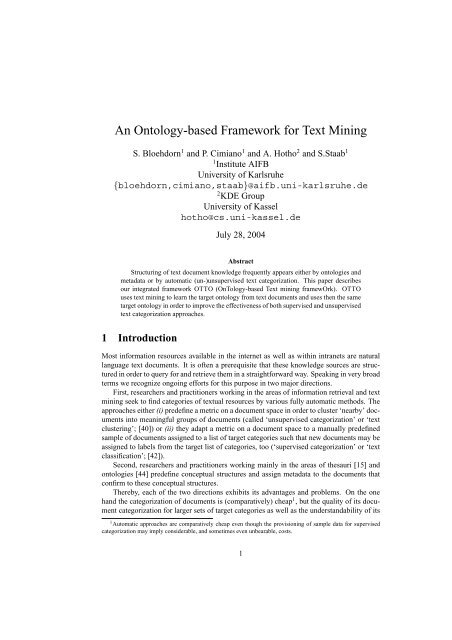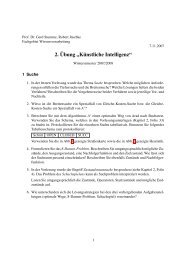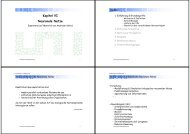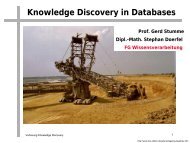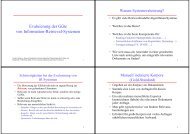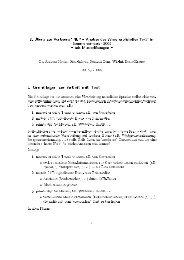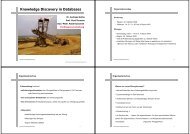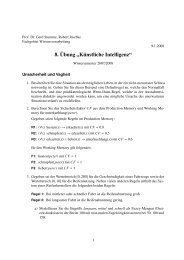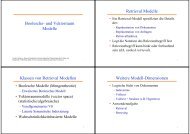An Ontology-based Framework for Text Mining
An Ontology-based Framework for Text Mining
An Ontology-based Framework for Text Mining
Create successful ePaper yourself
Turn your PDF publications into a flip-book with our unique Google optimized e-Paper software.
<strong>An</strong> <strong>Ontology</strong>-<strong>based</strong> <strong>Framework</strong> <strong>for</strong> <strong>Text</strong> <strong>Mining</strong><br />
S. Bloehdorn 1 and P. Cimiano 1 and A. Hotho 2 and S.Staab 1<br />
1 Institute AIFB<br />
University of Karlsruhe<br />
{bloehdorn,cimiano,staab}@aifb.uni-karlsruhe.de<br />
2 KDE Group<br />
University of Kassel<br />
hotho@cs.uni-kassel.de<br />
July 28, 2004<br />
Abstract<br />
Structuring of text document knowledge frequently appears either by ontologies and<br />
metadata or by automatic (un-)unsupervised text categorization. This paper describes<br />
our integrated framework OTTO (OnTology-<strong>based</strong> <strong>Text</strong> mining framewOrk). OTTO<br />
uses text mining to learn the target ontology from text documents and uses then the same<br />
target ontology in order to improve the effectiveness of both supervised and unsupervised<br />
text categorization approaches.<br />
1 Introduction<br />
Most in<strong>for</strong>mation resources available in the internet as well as within intranets are natural<br />
language text documents. It is often a prerequisite that these knowledge sources are structured<br />
in order to query <strong>for</strong> and retrieve them in a straight<strong>for</strong>ward way. Speaking in very broad<br />
terms we recognize ongoing ef<strong>for</strong>ts <strong>for</strong> this purpose in two major directions.<br />
First, researchers and practitioners working in the areas of in<strong>for</strong>mation retrieval and text<br />
mining seek to find categories of textual resources by various fully automatic methods. The<br />
approaches either (i) predefine a metric on a document space in order to cluster ‘nearby’ documents<br />
into meaningful groups of documents (called ‘unsupervised categorization’ or ‘text<br />
clustering’; [40]) or (ii) they adapt a metric on a document space to a manually predefined<br />
sample of documents assigned to a list of target categories such that new documents may be<br />
assigned to labels from the target list of categories, too (‘supervised categorization’ or ‘text<br />
classification’; [42]).<br />
Second, researchers and practitioners working mainly in the areas of thesauri [15] and<br />
ontologies [44] predefine conceptual structures and assign metadata to the documents that<br />
confirm to these conceptual structures.<br />
Thereby, each of the two directions exhibits its advantages and problems. On the one<br />
hand the categorization of documents is (comparatively) cheap 1 , but the quality of its document<br />
categorization <strong>for</strong> larger sets of target categories as well as the understandability of its<br />
1 Automatic approaches are comparatively cheap even though the provisioning of sample data <strong>for</strong> supervised<br />
categorization may imply considerable, and sometimes even unbearable, costs.<br />
1
esults are often quite low. On the other hand, the quality of manual metadata may be very<br />
good, but the cost of building an ontology and adding manual metadata typically are one or<br />
several orders of magnitude higher than <strong>for</strong> automatic approaches.<br />
To gain both advantages, while diminishing both their drawbacks at once, we here propose<br />
an approach of integrated ontology learning and text mining framework, viz. OTTO<br />
(OnTology-<strong>based</strong> <strong>Text</strong> mining framewOrk). Our implementation of OTTO includes a number<br />
of methods <strong>for</strong> (semi-)automatic ontology construction (also called ontology learning;<br />
[32]) in order to provide <strong>for</strong> rich conceptual structures. Then, OTTO allows <strong>for</strong> exploitation<br />
of ontologies learned in this way by supervised or unsupervised text categorization.<br />
We have shown in multiple contributions that ontology learning may be per<strong>for</strong>med effectively<br />
[32, 10] and that text categorization may profit from ontologies [4, 23, 22]. The<br />
integration we propose here allows <strong>for</strong> a tight integration of the two approaches combining<br />
their advantages.<br />
The structure of the remainder of the paper is as follows: in Section 2 we introduce<br />
the overall OTTO text mining framework. In Section 3 we first present the TEXTTOONTO<br />
system, which is designed to support the ontology engineer in the development of domain<br />
ontologies by applying text mining techniques. In this section we focus in particular on<br />
recent developments — as compared to [32]. In Section 4 we describe the approaches to text<br />
clustering and classification making use of ontologies as background knowledge. In Section<br />
5 we discuss some related work and Section 6 concludes the paper.<br />
2 General Architecture and <strong>Ontology</strong> Model<br />
Figure 1 illustrates the overall OTTO system architecture. The architecture builds upon the<br />
Karlsruhe <strong>Ontology</strong> and Semantic Web Infrastructure (KAON) 2 that provides the access to<br />
implementations of our <strong>for</strong>mal ontology model.<br />
<strong>Ontology</strong> Model and Infrastructure KAON is a general and multi-functional open source<br />
ontology management infrastructure and tool suite developed at Karlsruhe University. KAON<br />
is built around the <strong>Ontology</strong>-Instance-Model (OI-model), a <strong>for</strong>mal ontology model. In what<br />
follows we present our definition of an ontology which constitutes the <strong>for</strong>mal model underlying<br />
an OI-model and we sketch the basic KAON system infrastructure. However, we only<br />
describe those parts of our more extensive ontology definition [12] that are needed <strong>for</strong> this<br />
paper.<br />
Definition 2.1 (Core <strong>Ontology</strong>) A core ontology is a structure<br />
O := (C, ≤ C , R, σ, ≤ R )<br />
consisting of two disjoint sets C and R whose elements are called concept identifiers and<br />
relation identifiers, resp., a partial order ≤ C on C, called concept hierarchy or taxonomy, a<br />
function σ : R → C + called signature, a partial order ≤ R on R, called relation hierarchy,<br />
where r 1 ≤ R r 2 implies |σ(r 1 )| = |σ(r 2 )| and π i (σ(r 1 )) ≤ C π i (σ(r 2 )), <strong>for</strong> each 1 ≤<br />
i ≤ |σ(r 1 )| and C + is the set of tuples over C with at least one element and π i is the i-th<br />
component of a given tuple.<br />
2 http://kaon.semanticweb.org<br />
2
Natural Language<br />
<strong>Text</strong> Documents<br />
Document<br />
Metadata<br />
Indexing Expert<br />
Document Management Components<br />
Linguistic <strong>An</strong>alysis Components<br />
External<br />
Resources:<br />
<strong>Text</strong>ToOnto<br />
<strong>Ontology</strong><br />
Learning<br />
Components<br />
<strong>Ontology</strong>-Instance<br />
Model<br />
KAON API<br />
Term &<br />
Concept<br />
Feature<br />
Extraction<br />
Components<br />
WordNet<br />
GUI<br />
GUI Components<br />
Machine<br />
Learning<br />
Components<br />
<strong>Ontology</strong> Engineer<br />
Cluster Output<br />
Classification Output<br />
Figure 1: Overall OTTO System Architecture<br />
Definition 2.2 (Subconcepts and Superconcepts) If c 1 < C c 2 <strong>for</strong> any c 1 , c 2 ∈ C, then<br />
c 1 is a subconcept (specialization) of c 2 and c 2 is a superconcept (generalization) of c 1 . If<br />
c 1 < C c 2 and there exists no c 3 ∈ C with c 1 < C c 3 < C c 2 , then c 1 is a direct subconcept of<br />
c 2 , and c 2 is a direct superconcept of c 1 , denoted by c 1 ≺ c 2 .<br />
The partial order < C relates the concepts in an ontology in <strong>for</strong>m of specialization and<br />
generalization relationships, resulting in a hierarchical arrangement of concepts 3 . These<br />
relationships correspond to what is generally known as is-a or is-a-special-kind-of relations 4 .<br />
Often we will call concept identifiers and relation identifiers just concepts and relations,<br />
resp., <strong>for</strong> sake of simplicity. Almost all relations in practical use are binary. For those<br />
relations, we define their domain and their range.<br />
Definition 2.3 (Domain and Range) For a relation r ∈ R with |σ(r)| = 2, we define its<br />
domain and its range by dom(r) := π 1 (σ(r)) and range(r) := π 2 (σ(r)).<br />
According to the international standard ISO 704, we provide names <strong>for</strong> the concepts (and<br />
relations). Instead of ‘name’, we here call them ‘sign’ or ‘lexical entries’ to better describe<br />
the functions <strong>for</strong> which they are used.<br />
3 Note that this hierarchical structure is not necessarily a tree structure. It may also be a directed acyclic graph<br />
possibly linking concepts to multiple superconcepts at the same time.<br />
4 In ontologies that are more loosely defined, the hierarchy may, however, not be as explicit as is-a relationships<br />
but rather correspond to the notion of narrower-than vs. broader-than. Note, however, that in many settings this<br />
view is considered as a very bad practice as it may lead to inconsistencies when reasoning with ontologies. However,<br />
this problem is not preeminent in the context of this work [49].<br />
3
Definition 2.4 (Lexicon <strong>for</strong> an <strong>Ontology</strong>) A lexicon <strong>for</strong> an ontology O is a tuple Lex :=<br />
(S C , Ref C ) consisting of a set S C , whose elements are called signs <strong>for</strong> concepts (symbols),<br />
and a relation Ref C ⊆ S C × C called lexical reference <strong>for</strong> concepts, where (c, c) ∈ Ref C<br />
holds <strong>for</strong> all c ∈ C ∩S C . Based on Ref C , <strong>for</strong> s ∈ S C we define Ref C (s) := {c ∈ C|(s, c) ∈<br />
Ref C }. <strong>An</strong>alogously, <strong>for</strong> c ∈ C it is Ref −1<br />
C<br />
(c) := {s ∈ S C|(s, c) ∈ Ref C }. <strong>An</strong> ontology<br />
with lexicon is a pair (O, Lex) where O is an ontology and Lex is a lexicon <strong>for</strong> O.<br />
While the above definitions are related to the intensional and lexical aspects of an ontology,<br />
the following definition of a knowledge base relates to its extensional aspects:<br />
Definition 2.5 (Knowledge Base) A knowledge base is a structure<br />
KB := (C KB , R KB , I, ι C , ι R )<br />
consisting of two sets C KB and R KB , a set I whose elements are called instance identifiers<br />
(or instances or objects <strong>for</strong> short), a function ι C : C KB → P(I) called concept instantiation,<br />
a function ι R : R KB → P(I + ) with ι R (r) ⊆ ∏ c∈σ(r) ι C(c), <strong>for</strong> all r ∈ R. The function ι R<br />
is called relation instantiation,<br />
where P(M) stands <strong>for</strong> the powerset of a set M and ∏ i<br />
M i <strong>for</strong> the cross-product of the<br />
sets M i .<br />
KAON features a full-fledged API that allows programmatic access to different implementations<br />
of the <strong>for</strong>mal ontology model described. Currently, two different implementations<br />
of the KAON API are available: whereas the KAON Engineering Server is an ontology<br />
server using a scalable database representation of ontologies, APIonRDF is a main-memory<br />
implementation of the KAON API <strong>based</strong> on RDFS, a simple modelling language on top of<br />
the Resource Description <strong>Framework</strong> (RDF) <strong>for</strong>malism, both being developed by the W3C.<br />
KAON OI-modeler provides a graphical environment <strong>for</strong> ontology editing.<br />
OTTO <strong>Text</strong> <strong>Mining</strong> Extensions OTTO’s architecture is organized around KAON’s OImodel<br />
and features various text mining modules (Figure 1). Separate document corpus management<br />
components allow to manage text document corpora and associated metadata in<strong>for</strong>mation.<br />
<strong>An</strong>other core group of components offers basic linguistic analysis services like<br />
stemming, POS pattern analysis, word frequency calculations and the like, which are commonly<br />
used by all other components. The TEXTTOONTO ontology learning algorithms,<br />
some of which will be described in section 3, can be applied to learn ontological structures<br />
from document corpora which are then stored in a corresponding OI-model. Some of the<br />
TEXTTOONTO modules also make use of external resources like WordNet or Google in<br />
order to query the WWW. Comprehensible GUIs provide intuitive access to the learning<br />
algorithms as well as to the OI-model <strong>for</strong> the user. On the other hand, given that a suitable<br />
ontology is available, the OTTO concept extraction components allow to analyze text<br />
documents and extract a conceptual document representation that complements the classical<br />
bag-of-words document representation. We will have a closer look at these modules in<br />
section 3. The feature extraction components are carefully designed to allow flexible connections<br />
to different software modules that are capable to per<strong>for</strong>m classical machine learning<br />
algorithms like classification or clustering. Implemented connectors include connectors to<br />
Weka 5 , a Java <strong>based</strong> machine-learning library and application, or MATLAB.<br />
5 http://www.cs.waikato.ac.nz/ ∼ ml/weka/<br />
4
3 The <strong>Text</strong>ToOnto <strong>Ontology</strong> Learning <strong>Framework</strong><br />
<strong>Text</strong>ToOnto 6 is a system conceived to support the ontology engineer in the task of creating<br />
and maintaining ontologies. For this purpose, it employs text mining techniques such as term<br />
clustering and matching of lexico-syntactic patterns as well as other resources of a general<br />
nature such as WordNet [14]. In what follows, we describe the architecture as well as the<br />
algorithms used by the system to facilitate the ontology engineering process.<br />
3.1 The <strong>Text</strong>ToOnto Architecture<br />
The main components of <strong>Text</strong>ToOnto are the following (compare [32] as well as Figure 2):<br />
• The <strong>Ontology</strong> Management Component provides basic ontology management functionality.<br />
In particular, it supports editing, browsing and evolution of ontologies. For<br />
this purpose it builds upon the Karlsruhe <strong>Ontology</strong> and Semantic Web Infrastructure<br />
(KAON). In fact, KAON’s OI-model is the key data structure on which the ontology<br />
learning process is centered.<br />
• The Algorithm Library Component acts as the algorithmic backbone of the framework.<br />
It incorporates a number of text mining methods, e.g. conceptual clustering,<br />
terminology extraction, pattern matching as well as machine learning techniques, e.g.<br />
association rules and classifiers.<br />
• Coordination Component: The ontology engineer uses this component to interact<br />
with the different ontology learning algorithms from the algorithm library. Comprehensive<br />
user interfaces are provided to select relevant corpora, set different parameters<br />
and start the various algorithms.<br />
From a methodological point of view, the data structure around which the whole ontology<br />
learning process is centered is the OI-model as described in Section 2. The user can start with<br />
an empty OI-model and learn a new ontology from scratch or select an existing one and add<br />
new instances or relations. In this paper we do not describe all these components in detail,<br />
but refer the reader to [32] instead. The main contribution of the present section is in fact to<br />
present new components extending the functionalities of the system as described therein.<br />
3.2 <strong>Ontology</strong> Learning Algorithms<br />
In earlier work, we presented approaches <strong>for</strong> learning taxonomic relations via (i) top-down<br />
or bottom-up clustering techniques [30, 10], (ii) matching lexico-semantic patterns or (iii)<br />
classification algorithms such as k-Nearest-Neighbours [31]. Further, we also developed<br />
algorithms <strong>for</strong> extracting general binary relations between concepts <strong>based</strong> on association<br />
rules mining [33]. <strong>An</strong>other possibility we examined is to extract domain ontologies from<br />
large, domain independent ontologies by pruning [47]. In this paper we present three new<br />
algorithms actually implemented within <strong>Text</strong>ToOnto with the purpose of:<br />
• constructing taxonomies using a conceptual clustering algorithm, i.e. Formal Concept<br />
<strong>An</strong>alysis (TaxoBuilder component)<br />
6 The system is freely available and can be downloaded at http://source<strong>for</strong>ge.net/projects/texttoonto/<br />
5
Figure 2: <strong>Text</strong>ToOnto Architecture<br />
• constructing taxonomies by combining in<strong>for</strong>mation aggregated from WordNet, Hearst<br />
[20] patterns matched in a corpus as well as certain heuristics (TaxoBuilder component)<br />
• classifying instances into the ontology by using lexico-syntactic patterns (InstanceExtraction<br />
component)<br />
• extracting labelled relations and specifying their domain and range (RelationLearning<br />
component)<br />
3.2.1 TaxoBuilder<br />
TaxoBuilder is a component developed <strong>for</strong> the purpose of learning concept hierarchies from<br />
scratch. It can be used in two different modes:<br />
• In FCA mode, TaxoBuilder employs the technique described in [9] to learn a concept<br />
hierarchy by means of Formal Concept <strong>An</strong>alysis [16].<br />
• In Combination mode, TaxoBuilder uses different sources of evidence such as Word-<br />
Net, Hearst patterns [20] matched in a corpus as well as certain heuristics to find<br />
taxonomic relations.<br />
In the FCA mode, TaxoBuilder extracts syntactic dependencies from text by applying<br />
shallow parsing techniques. In particular it extracts verb-object relations and uses them as<br />
context attributes <strong>for</strong> Formal Concept <strong>An</strong>alysis as described in [9] and [10]. The lattice is<br />
then built in the background and trans<strong>for</strong>med into an OI-model by removing the bottom <strong>for</strong>mal<br />
concept and introducing <strong>for</strong> every <strong>for</strong>mal concept an ontological concept named with its<br />
intent. For every element in the extension of this <strong>for</strong>mal concept we introduce an ontological<br />
subconcept. Figure 3 shows <strong>for</strong> example the lattice automatically learned <strong>for</strong> the following<br />
terms: apartment, hotel, car, bike and trip. The corresponding <strong>for</strong>mal context is depicted in<br />
Table 1. As already mentioned, the lattice is calculated in the background and trans<strong>for</strong>med<br />
into the OI-model in Figure 4.<br />
6
unable offerable needable startable meanable seemable attemptable cruiseable fillable<br />
apartment x<br />
hotel x x<br />
car<br />
bike<br />
x<br />
x<br />
trip x x x x x<br />
Table 1: Formal Context <strong>for</strong> the terms apartment, hotel, car, bike and trip<br />
Figure 3: Concept Lattice<br />
This approach has been evaluated in [9] and [10] by comparing the automatically generated<br />
concept hierarchies with handcrafted hierarchies <strong>for</strong> a given domain in terms of the<br />
similarity measures described in [31].<br />
In the Combination mode, TaxoBuilder exploits (i) the vertical relations heuristic in [34], (ii)<br />
Hearst patterns [20] as well as (iii) the hypernym relations in WordNet [14]. Now given a<br />
pair of terms, say t 1 and t 2 , they could be taxonomically related in two ways: is-a(t 1 ,t 2 ) or<br />
is-a(t 2 ,t 1 ). In order to decide in which way they are related we compute the evidence <strong>for</strong><br />
both of the relations by taking into account the above in<strong>for</strong>mation sources. In particular, we<br />
take into account the above mentioned heuristic, the number of Hearst patterns in the corpus<br />
found as well as the number of hypernymic paths in WordNet between two terms. We<br />
sum up all these values and choose the relation with maximum evidence. All the taxonomic<br />
relations found in this way between a given set of terms in question are then added to the OImodel<br />
after removing potential cycles. This method has been proven to be an effective way<br />
of quickly learning concept hierarchies. Figure 5 shows a concept hierarchy automatically<br />
acquired with the combination method out of 500 texts from the online Lonely Planet world<br />
guide 7 .<br />
3.2.2 InstanceExtraction<br />
The InstanceExtraction component discovers instances of concepts of a given ontology in a<br />
text corpus. So, it needs a text corpus and a non-empty OI-model as input. It can either be<br />
used in a semi-automatic or fully automatic way. In the first case, it will present the candidate<br />
instances to the user asking <strong>for</strong> confirmation, while in the second case it will simply add the<br />
discovered instances to the corresponding OI-model. In order to discover these instances,<br />
7 http://www.lonelyplanet.com<br />
7
Figure 4: OI-model automatically learned with the FCA approach<br />
Figure 5: OI-model automatically learned with the combination approach<br />
8
InstanceExtraction makes use of a combination of patterns from [20] and [18]. The user can<br />
choose which of the different patterns s/he wants to use. The patterns are described in what<br />
follows:<br />
Hearst Patterns The first four patterns have been used by Hearst to identify is-a-relationships<br />
between the concepts referred by two terms in the text. However, they can also be used to<br />
categorize a named entity or instance into an ontology. In our approach we have the underlying<br />
assumption that common nouns represent concepts and proper nouns represent instances.<br />
In order to identify noun phrases representing concepts, hence<strong>for</strong>th NP CONCEP T , and noun<br />
phrases representing instances, hence<strong>for</strong>th NP INST ANCE , we use a shallow parsing technique<br />
<strong>based</strong> on matching regular expressions over part-of-speech tags to identify the two<br />
types of noun phrases described above. The patterns reused from Hearst are:<br />
HEARST1: NP CONCEP T such as NP INST ANCE<br />
HEARST2: such NP CONCEP T as NP INST ANCE<br />
HEARST3: NP CONCEP T , (especially|including) NP INST ANCE<br />
HEARST4: NP INST ANCE (and|or) other NP CONCEP T<br />
The above patterns would match the following expressions (in this order): hotels such as<br />
Ritz; such hotels as Hilton; presidents, especially George Washington; and the Eiffel Tower<br />
and other sights in Paris.<br />
Definites The next patterns are about definites, i.e. noun phrases introduced by the definite<br />
determiner ‘the’. Frequently, definites actually refer to some entity previously mentioned in<br />
the text. In this sense, a phrase like ‘the hotel’ does not stand <strong>for</strong> itself, but it points as a<br />
so-called anaphora to a unique hotel occurring in the preceding text. Nevertheless, it has also<br />
been shown that in common texts more than 50% of all definite expressions are non-referring,<br />
i.e. they exhibit sufficient descriptive content to enable the reader to uniquely determine the<br />
entity referred to from the global context [37]. For example, the definite description ‘the<br />
Hilton hotel’ has sufficient descriptive power to uniquely pick-out the corresponding realworld<br />
entity <strong>for</strong> most readers. One may deduce that ‘Hilton’ is the name of the real-world<br />
entity of type hotel to which the above expression refers.<br />
Consequently, we apply the following two patterns to categorize candidate proper nouns<br />
by definite expressions:<br />
DEFINITE1: the NP INST ANCE NP CONCEP T<br />
DEFINITE2: the NP CONCEP T NP INST ANCE<br />
The first and the second pattern would, e.g., match the expressions ‘the Hilton hotel’ and ‘the<br />
hotel Hilton’, respectively.<br />
9
Pattern Suggested <strong>An</strong>notator1 <strong>An</strong>notator 2 <strong>An</strong>notator 3 Accuracy<br />
HEARST1 2 40.00% 40.00% 60.00% 46.66%<br />
DEFINITE1 19 21.05% 36.84% 36.84% 31.56%<br />
DEFINITE2 74 91.36% 93.83% 96.30% 93.83%<br />
APPOSITION 28 56.00% 62.00% 62.00% 60.00%<br />
COPULA 22 66.67% 66.67% 63.64% 65.66%<br />
ALL 188 69.15% 73.40% 74.47% 72.34%<br />
Table 2: Accuracy of each of the patterns<br />
Apposition and Copula The following pattern makes use of the fact that certain entities<br />
appearing in a text are further described in terms of an apposition as in ‘Excelsior, a hotel in<br />
the center of Nancy’. The pattern capturing this intuition looks as follows:<br />
APPOSITION: NP INST ANCE , a NP CONCEP T<br />
The probably most explicit way of expressing that a certain entity is an instance of a<br />
certain concept is by the verb ‘to be’, as <strong>for</strong> example in ‘The Excelsior is a hotel in the center<br />
of Nancy’. Here’s the general pattern:<br />
COPULA: NP INST ANCE is a NP CONCEP T<br />
Evaluation In order to evaluate our pattern-<strong>based</strong> approach to categorizing instances, we<br />
considered the 500 randomly selected web pages from Lonely Planet and used a part-ofspeech<br />
(POS) tagger 8 as well handcrafted rules to match non-recursive NPs representing<br />
concepts and instances, respectively, as well as the above patterns.<br />
We then presented the found instance-concept pairs to three different subjects <strong>for</strong> validation.<br />
They had the possibility of validating the relationship, adding the concept name to the instance,<br />
rejecting the relationship or expressing their doubt. The possibility of adding the<br />
concept name is important when judging a suggestion such as that Lenin is an instance of a<br />
museum. In this case, the users could decide that the suggestion of the system is not totally<br />
wrong and correct the suggestion by specifying that Lenin museum is the actual instance of<br />
a museum. In this case we counted the answer of the system as correct. Table 2 gives the<br />
accuracy <strong>for</strong> all the patterns <strong>based</strong> on the answers of the human subjects to the suggestions of<br />
the system. Un<strong>for</strong>tunately, no HEARST2, HEARST3 or HEARST4 instances were found in<br />
the texts, which shows that they are actually the ones which occur most rarely. Interestingly,<br />
it can be appreciated that the accuracy varies from pattern to pattern. Overall, the per<strong>for</strong>mance<br />
of the approach seems very reasonable as more than 72% of the suggested relations<br />
are judged as correct by the human subjects.<br />
3.2.3 RelationLearning<br />
The RelationLearning component also discovers candidate relations from text but in contrast<br />
to the association rule algorithm described in [32] suggests a name <strong>for</strong> the relation to the user<br />
as well as domain and range <strong>for</strong> it. For this purpose, it employs a shallow parsing strategy to<br />
extract subcategorization frames enriched with selectional restrictions specified with regard<br />
to the corresponding OI-model as described in [39]. In particular, it extracts the following<br />
syntactic frames:<br />
8 We used the QTag POS-Tagger available at http://web.bham.ac.uk/O.Mason/software/tagger/<br />
10
• transitive, e.g. love(subj,obj)<br />
• intransitive + PP-complement, e.g. walk(subj,pp(to))<br />
• transitive + PP-complement, e.g. hit(subj,obj,pp(with))<br />
RelationLearning then enriches these subcategorization frames semantically by finding<br />
the appropriate concept from a given ontology <strong>for</strong> each syntactic position. For each occurrence<br />
of a given syntactic frame, it extracts the nominal head in each syntactic position and<br />
augments the corresponding concept count by one. For each syntactic frame and syntactic<br />
position it chooses the most specific concept with maximal count. On the basis of these subcategorization<br />
frames, it suggests possible relations to the user <strong>for</strong> validation. For example,<br />
given the following enriched subcategorization frames<br />
love(subj:person,obj:person)<br />
walk(subj:person,to:place)<br />
hit(subj:person,obj:thing,with:contundent object)<br />
the system would suggest the following relations to the user:<br />
love(domain:person,range:person)<br />
walk to(domain:person,range:place)<br />
hit(domain:person,range:thing)<br />
hit with(domain:person,range:contundent object)<br />
The main problem with this approach to discovering relations is related to data sparseness<br />
as <strong>for</strong> small to medium-sized corpora there are not enough verbs in the text collection<br />
connecting all the different concepts of the ontology together. In general with this approach<br />
we thus end up with only a small number of relations.<br />
4 <strong>Ontology</strong>-<strong>based</strong> <strong>Text</strong> Clustering and Classification<br />
Due to the ever growing amounts of textual in<strong>for</strong>mation available electronically, users are<br />
facing the challenge of organizing, analyzing and searching large numbers of documents.<br />
Systems that automatically classify text documents into predefined thematic classes or detect<br />
clusters of documents with similar content offer a promising approach to tackle this<br />
complexity. During the last decades, a large number of machine learning algorithms have<br />
been proposed <strong>for</strong> supervised and unsupervised text categorization. So far, however, existing<br />
text categorization systems have typically used the Bag–of–Words model known from<br />
in<strong>for</strong>mation retrieval, where single words or word stems are uses as features <strong>for</strong> representing<br />
document content [40]. In this section we present an approach that exploits existing ontologies<br />
by using their lexica and concept hierarchies to improve results in both, supervised and<br />
unsupervised settings.<br />
4.1 The Bag-of-Words Model<br />
In the Bag–of–Words paradigm, documents are represented as bags of terms. Let D be the<br />
set of documents and T = {t 1 , . . . , t m } the set of all different terms occurring in D. The<br />
absolute frequency of term t ∈ T in document d ∈ D is given by tf(d, t). Term vectors are<br />
denoted ⃗t d = (tf(d, t 1 ), . . . , tf(d, t m )).<br />
11
Stopwords and Stemming The initial term vectors produced so far in this approach can<br />
be further modified as described in what follows. Stopwords are words which are considered<br />
as non–descriptive within a bag–of–words approach. For example, <strong>for</strong> english language, it is<br />
common practice to use a standard list of 571 stopwords initially designed <strong>for</strong> the SMART<br />
system 9 . Typically, text documents are further processed to reduce the term representation<br />
to term stems, e.g. using the Porter stemmer introduced in [38]. Using stemmed terms, one<br />
can construct a vector representation ⃗t d <strong>for</strong> each text document.<br />
Pruning Pruning rare terms also affects results. Depending on a pre-defined threshold δ,<br />
a term t is discarded from the representation (i. e., from the set T ), if ∑ d∈D<br />
tf(d, t) ≤ δ. In<br />
our experiments, we have <strong>for</strong> example used the values 0, 5 and 30 <strong>for</strong> δ. The rationale behind<br />
pruning is that infrequent terms do not help <strong>for</strong> identifying appropriate clusters, but may still<br />
add noise to the distance measures degrading overall per<strong>for</strong>mance.<br />
Weighting Having extracted the collection of terms that make up the documents in a corpus,<br />
the corresponding numeric values of the terms within the document have to be determined.<br />
A special case of term weighting is binary weighting, where the terms are represented<br />
as boolean variables. Tfidf weighs the frequency of a term in a document with<br />
a factor that discounts its importance when it appears in almost all documents. The tfidf<br />
(term frequency−inverted document frequency) )<br />
10 of term t in document d is defined by:<br />
tfidf(d, t) := log(tf(d, t) + 1) ∗ log where df(t) is the document frequency of term t<br />
(<br />
|D|<br />
df(t)<br />
that counts in how many documents term t appears. If tfidf weighting is applied then we replace<br />
the term vectors ⃗t d := (tf(d, t 1 ), . . . , tf(d, t m )) by ⃗t d := (tfidf(d, t 1 ), . . . , tfidf(d, t m )).<br />
There are more sophisticated measures than tfidf in the literature (see, e. g., [2]), but we abstract<br />
herefrom, as this is not the main topic of this paper.<br />
Deficiencies By using only single terms to represent document content any chosen machine<br />
learning algorithm is restricted to detecting patterns in the used terminology only, while conceptual<br />
patterns remain ignored. Specifically, systems using only words as features exhibit a<br />
number of inherent deficiencies:<br />
1. Multi-Word Expressions with an own meaning like “European Union” are chunked<br />
into pieces with possibly very different meanings like “union”.<br />
2. Synonymous Words like “tungsten” and “wolfram” are mapped into different features.<br />
3. Polysemous Words are treated as one single feature while they may actually have multiple<br />
distinct meanings.<br />
4. Lack of Generalization: there is no way to generalize similar terms like “beef” and<br />
“pork” to their common hypernym “meat”.<br />
While items 1 – 3 directly address issues that arise on the lexical level, items 4 rather<br />
addresses an issue that occurs at the conceptual level.<br />
In our approach, we use background knowledge in <strong>for</strong>m of simple ontologies (cf. section<br />
2) to improve text classification and clustering results by directly addressing these problems.<br />
9 ftp://ftp.cs.cornell.edu/pub/smart/english.stop<br />
10 tfidf actually refers to a class of weighting schemata. Above we have given the one we have used.<br />
12
We propose a hybrid approach <strong>for</strong> document representation <strong>based</strong> on the common term stem<br />
representation which is enhanced with concepts extracted from the used ontologies.<br />
4.2 Enriching the document vectors with concepts<br />
In our approach, we exploit background knowledge about concepts that is explicitly given<br />
according to our ontological model (cf. section 2). For this purpose, we extend each term<br />
vector ⃗t d by new entries <strong>for</strong> ontological concepts c appearing in the document set. Thus, the<br />
vector ⃗t d is replaced by the concatenation of ⃗t d with the concept vector ⃗c d := (cf(d, c 1 ), . . . ,<br />
cf(d, c l )) having length l = |C| and where cf(d, c) denotes the frequency of the appearance<br />
of concept c ∈ C in document d as indicated by applying the reference function Ref C to all<br />
terms in the document d. Hence, a term that also appears in the ontology would be accounted<br />
<strong>for</strong> at least twice in the new vector representation, i. e., once as part of the old ⃗t d and at least<br />
once as part of ⃗c d . It could be accounted <strong>for</strong> also more often, because a term like “bank” has<br />
several corresponding concepts in the ontology.<br />
To extract the concepts from texts, we have developed a detailed process, that can be used<br />
with any ontology with lexicon. The overall process comprises five processing steps that are<br />
described in the following.<br />
1. Candidate Term Detection Due to the existence of multi-word expressions, the mapping<br />
of terms to concepts can not be accomplished by querying the lexicon directly <strong>for</strong> the<br />
single words in the document.<br />
We have addressed this issue by developing a candidate term detection algorithm [4] that<br />
builds on the basic assumption that finding the longest multi-word expressions that appear in<br />
the text and the lexicon will lead to a mapping to the most specific concepts. The algorithm<br />
works by moving a window over the input text, analyzing the window content and either<br />
decreasing the window size if unsuccessful or moving the window further. For English, a<br />
window size of 4 is sufficient to detect virtually all multi-word expressions.<br />
2. Syntactical Patterns Querying the lexicon directly <strong>for</strong> any expression in the window<br />
will result in many unnecessary searches and thereby in high computational requirements.<br />
Luckily, unnecessary search queries can be identified and avoided through an analysis of<br />
the part-of-speech (POS) tags of the words contained in the current window. Concepts are<br />
typically symbolized in texts within noun phrases. By defining appropriate POS patterns<br />
and matching the window content against these, multi-word combinations that will surely<br />
not symbolize concepts can be excluded in the first hand and different syntactic categories<br />
can be disambiguated.<br />
3. Morphological Trans<strong>for</strong>mations Typically the lexicon will not contain all inflected<br />
<strong>for</strong>ms of its entries. If the lexicon interface or separate software modules are capable of<br />
per<strong>for</strong>ming base <strong>for</strong>m reduction on the submitted query string, queries can be processed<br />
directly. For example, this is the case with WordNet. If the lexicon, as in most cases, does<br />
not contain such functionalities, a simple fallback strategy can be applied. Here, a separate<br />
index of stemmed <strong>for</strong>ms is maintained. If a first query <strong>for</strong> the inflected <strong>for</strong>ms on the original<br />
lexicon turned out unsuccessful, a second query <strong>for</strong> the stemmed expression is per<strong>for</strong>med.<br />
13
4. Word Sense Disambiguation Having detected a lexical entry <strong>for</strong> an expression, this<br />
does not necessarily imply a one-to-one mapping to a concept in the ontology. Although<br />
multi-word-expression support and POS pattern matching reduce ambiguity, there may arise<br />
the need to disambiguate an expression versus multiple possible concepts. The word sense<br />
disambiguation (WSD) task is a problem in its own right [25] and was not the focus of our<br />
work.<br />
In our experiments, we have used three simple strategies proposed in [24] to process<br />
polysemous terms:<br />
• The ‘‘all” strategy leaves actual disambiguation aside and uses all possible concepts.<br />
• The ‘‘first” strategy exploits WordNet’s capability to return synsets ordered with respect<br />
to usage frequency. This strategy chooses the most frequent concept in case of<br />
ambiguities.<br />
• The ‘‘context” strategy per<strong>for</strong>ms disambiguation <strong>based</strong> on the degree of overlap of lexical<br />
entries <strong>for</strong> the semantic vicinity of candidate concepts and the document content<br />
as proposed in [24].<br />
5. Generalization The last step in the process is about going from the specific concepts<br />
found in the text to more general concept representations. However, we do not only add the<br />
concepts directly representing the terms but also the corresponding superconcept along the<br />
path to the root of the concept hierarchy. <strong>An</strong> important issue here is to restrict the number<br />
of levels up in the hierarchy considered <strong>for</strong> adding superconcepts. The following procedure<br />
realizes this idea by adding to the concept frequency of higher level concepts in a document d<br />
the frequencies of their subconcepts (of at most r levels down in the hierarchy). I. e., the vectors<br />
we consider are first of the <strong>for</strong>m ⃗t d := (tf(d, t 1 ), . . . , tf(d, t m ), cf(d, c 1 ), . . . , cf(d, c n ))<br />
(the concatenation of an initial term representation with a concept vector). Then the frequencies<br />
of the concept vector part are updated, <strong>for</strong> a user-defined r ∈ N 0 , in the following<br />
way: For all c ∈ C, replace cf(d, c) by cf ′ (d, c) := ∑ b∈H(c,r)<br />
cf(d, b), where<br />
H(c, r) := {c ′ |∃c 1 , . . . , c i ∈ C : c ′ ≺ c 1 ≺ · · · ≺ c i = c, 0 ≤ i ≤ r} gives <strong>for</strong> a<br />
given concept c the r next subconcepts in the taxonomy. In particular H(c, ∞) returns all<br />
subconcepts of c. This implies: The strategy r = 0 does not change the given concept frequencies,<br />
r = n adds to each concept the frequency counts of all subconcepts in the n levels<br />
below it in the ontology and r = ∞ adds to each concept the frequency counts of all its<br />
subconcepts.<br />
4.3 Machine Learning Components and Results<br />
As documents have been processed with the term and concept extraction components, they<br />
can be processed using standard machine learning algorithms. Currently, we use an interface<br />
that allows easy integration of the resulting hybrid document feature representations into<br />
WEKA 11 , a Java-<strong>based</strong> multi-purpose machine learning environment.<br />
Unsupervised <strong>Text</strong> Categorization (Clustering) deals with grouping documents together<br />
that are homogenous in some way. In contrast to supervised text categorization, where the<br />
classes in question are assigned outside the learning environment, it is the very task of the<br />
clustering algorithm to find good groups (clusters) in the first hand when no classes are given<br />
a priori.<br />
11 see: http://www.cs.waikato.ac.nz/ml/weka/<br />
14
For clustering [45], it has been shown that Bi-Section-KMeans – a variant of KMeans<br />
– frequently outper<strong>for</strong>ms standard KMeans as well as agglomerative clustering techniques.<br />
Thus, we make use of Bi-Section-KMeans as clustering method. The similarity between two<br />
text documents d 1 , d 2 ∈ D is measured by the cosine of the angle between the vectors ⃗t 1 ,⃗t 2<br />
representing them: cos(∢(⃗t 1 ,⃗t 2 )) = ⃗ t 1·⃗t 2<br />
.<br />
‖⃗t 1 ‖·‖⃗t 2 ‖<br />
In experiments reported in a previous paper [24], we showed that conceptual representations<br />
can significantly improve text cluster purity by reducing the variance among the representations<br />
within the given classes of related documents. In the experiments on the wellknown<br />
Reuters-21578 corpus using WordNet as ontology, we were able to show a significant<br />
improvement of up to 8% using a simple word sense disambiguation strategy combined with<br />
generalization <strong>based</strong> on term and concept vectors. We observed a per<strong>for</strong>mance drop without<br />
using any word sense disambiguation. <strong>An</strong> investigation of the different clusters revealed that<br />
some given classes of the Reuters corpus could be found with a high purity by the clustering<br />
algorithm while <strong>for</strong> other classes purity decreases.<br />
Supervised <strong>Text</strong> Categorization Not surprisingly, supervised text categorization and clustering<br />
are closely related as both are concerned with “groupings” of objects. However, in the<br />
supervised setting, these groupings are given by the common membership to a thematic class<br />
that is assigned to sample documents be<strong>for</strong>e the training process starts. The training process<br />
then induces hypotheses of how the document space is shaped according to which new documents<br />
are assigned target categorizations.<br />
Many different supervised categorization algorithms have been designed and virtually<br />
all of them have been used <strong>for</strong> text categorization tasks, including probabilistic classifiers<br />
like Naïve Bayes, Linear Discriminant Functions like Perceptrons or more recently Support<br />
Vector Machines, Decision Trees and Decision Rule Classifiers, Nonparametric Classifiers<br />
like k-Nearest-Neighbours and Ensemble Classifiers, most namely Bagging and Boosting.<br />
Comparisons like in [42] suggest that Boosting [41] and Support Vector Machines [26] are<br />
the most promising approaches <strong>for</strong> handling text classification tasks.<br />
In a recent experimental evaluation on two well-known text corpora [4], the Reuters-<br />
21578 corpus and the medical document corpus OHSUMED, were able to show the positive<br />
effects of our approach. Using Boosting as actual learning algorithm and both, term stems<br />
and concepts as features, we were able to achieve consistent improvements of the categorization<br />
results. In terms of the well-known F 1 measure, that combines precision and recall<br />
results this improvement was in the 1% – 3% range <strong>for</strong> the Reuters-21578 corpus and in the<br />
2.5% – 7% range <strong>for</strong> the OHSUMED corpus 12 . The difference between both evaluations is<br />
probably explained best by the fact that the medical documents in the OHSUMED corpus<br />
make heavy use of multi-word-expressions, synonyms and very specific terms which obfuscates<br />
a pure term <strong>based</strong> representation very much, while conceptual features tend to reduce<br />
noise in these situations.<br />
5 Related Work<br />
In this section we discuss work related to text mining techniques <strong>for</strong> ontology learning as<br />
well as text clustering and classification techniques relying on background knowledge.<br />
12 These figures are <strong>based</strong> on macro-averaged F 1 results with micro-averaged results being slightly worse on the<br />
Reuters-21578 corpus while being fairly similar on the OHSUMED corpus.<br />
15
<strong>Ontology</strong> Learning There is quite a long tradition in learning concept hierarchies by clustering<br />
approaches such as the ones presented in [21, 35, 13, 7, 3] as well as by matching<br />
lexico-syntactic patterns as described in [20, 19, 8, 36, 1, 27, 43, 11]. In this section we<br />
focus on the discussion of frameworks and systems designed <strong>for</strong> supporting the ontology<br />
engineering process. In the ASIUM system [13] nouns appearing in similar contexts are iteratively<br />
clustered in a bottom-up fashion. In particular, at each iteration, the system clusters<br />
the two most similar extents of some argument position of two verbs and asks the user <strong>for</strong><br />
validation. Bisson et al. [3] present an interesting framework and a corresponding workbench<br />
- Mo’K - allowing users to design conceptual clustering methods to assist them in an<br />
ontology building task. The framework is general enough to integrate different clustering<br />
methods. Velardi et al. [46] present the OntoLearn system which discovers i) the domain<br />
concepts relevant <strong>for</strong> a certain domain, i.e. the relevant terminology, ii) named entities, iii)<br />
’vertical’ (is-a or taxonomic) relations as well as iv) certain relations between concepts <strong>based</strong><br />
on specific syntactic relations. In their approach a ’vertical’ relation is established between a<br />
term t 1 and a term t 2 , i.e. is-a(t 1 ,t 2 ), if the head of t 2 matches the head of t 1 and additionally<br />
the <strong>for</strong>mer is additionally modified in t 1 . Thus, a ’vertical’ relation is <strong>for</strong> example established<br />
between the term ’international credit card’ and the term ’credit card’, i.e. is-a(international<br />
credit card,credit card).<br />
Background Knowledge <strong>for</strong> <strong>Text</strong> Categorization Tasks To date, the work on integrating<br />
semantic background knowledge into text categorization is quite scattered. Much of the early<br />
work with semantic background knowledge in in<strong>for</strong>mation retrieval was done in the context<br />
of query expansion techniques [5]. Others like Green [17] or Dave et.al. [29] were more or<br />
less successful in using WordNet synsets to improve the text clustering task. Further they<br />
only investigate the use of WordNet and not ontologies in general by only applying a small<br />
number of strategies of the kind that we have investigated.<br />
Recent experiments with conceptual feature representations <strong>for</strong> supervised text categorization<br />
are presented in [48]. These and other similar published results are, however, still<br />
too few to allow insights on whether positive results can be achieved in general. In some<br />
cases, even negative results were reported. For example, a comprehensive comparison of approaches<br />
with different document representations <strong>based</strong> on word senses and different learning<br />
algorithms ends with the conclusion of the authors that “the use of word senses does<br />
not result in any significant categorization improvement” [28]. While we have been able<br />
to confirm the results they achieved <strong>for</strong> their method inventory, we have also shown that an<br />
enriched set of methods improves results by a large margin. In particular, we have found that<br />
ontology-<strong>based</strong> approaches benefit from feature weighting and word sense disambiguation.<br />
Alternative approaches <strong>for</strong> conceptual representations of text documents that are not<br />
<strong>based</strong> on background knowledge compute kind of “statistical” concepts. Very good results<br />
with a probabilistic variant of LSA known as Probabilistic Latent Semantic <strong>An</strong>alysis (pLSA)<br />
were recently reported in [6]. The experiments reported therein are of particular interest as<br />
the classification was also <strong>based</strong> on AdaBoost and was also using a combined term-concept<br />
representation, the latter being however automatically extracted from the document corpus<br />
using pLSA. We have investigated some of these approaches. We have been able to show<br />
that indeed LSA improves text clustering. In addition, we could show that ontology <strong>based</strong><br />
approaches further improve the results achieved by LSA. Further comparisons with pLSA<br />
remain to be done in future research.<br />
16
6 Conclusion and Further Work<br />
Exploiting knowledge present in textual documents is an important issue in building systems<br />
<strong>for</strong> knowledge management and related tasks. In this paper we have presented OTTO<br />
(OnTology-<strong>based</strong> <strong>Text</strong> mining framewOrk), a framework centered around the KAON OImodel<br />
<strong>for</strong> the interaction between ontologies, i.e. explicit <strong>for</strong>malizations of a shared conceptualization<br />
and natural language texts in two directions.<br />
First, natural language processing techniques combined with machine learning algorithms<br />
allow to build or extend ontologies in a semi-automatic manner. This field, known<br />
as ontology learning, is critical <strong>for</strong> building domain specific ontologies with fewer manual<br />
ef<strong>for</strong>t. We have presented recent innovations in this field that have been implemented in the<br />
TEXTTOONTO modules of our OTTO framework.<br />
Second, background knowledge in <strong>for</strong>m of ontologies enhances the per<strong>for</strong>mance of classical<br />
text mining tasks such as text classification and text clustering. Semantic features extracted<br />
from ontologies with help of the OTTO text mining components leverage the classical<br />
bag–of–words representation to a higher semantic level and thereby improve classification<br />
accuracy and cluster purity.<br />
Future work in this area will focus on a more thorough analysis how domain ontologies<br />
learned by means of ontology learning techniques can improve text classification and clustering<br />
tasks on documents from the same corpus, compared to using general purpose ontologies<br />
or linguistic resources like WordNet. Preliminary results show that this is a promising approach<br />
and will heavily influence the design of future OTTO module extensions.<br />
References<br />
[1] K. Ahmid, M. Tariq, B. Vrusias, and C. Handy. Corpus-<strong>based</strong> thesaurus construction<br />
<strong>for</strong> image retrieval in specialist domains. In Proceedings of the 25th European Conference<br />
on Advances in In<strong>for</strong>mation Retrieval (ECIR), 2003.<br />
[2] G. Amati, C. Carpineto, and G. Romano. Fub at trec-10 web track: A probabilistic<br />
framework <strong>for</strong> topic relevance term weighting. In TREC 2001. online publication, 2001.<br />
[3] G. Bisson, C. Nedellec, and L. Canamero. Designing clustering methods <strong>for</strong> ontology<br />
building - The Mo’K workbench. In Proceedings of the ECAI <strong>Ontology</strong> Learning<br />
Workshop, 2000.<br />
[4] S. Bloehdorn and A. Hotho. Boosting <strong>for</strong> <strong>Text</strong> Classification with Semantic Features.<br />
In Proceedings of the MSW 2004 workshop at the 10th ACM SIGKDD Conference on<br />
Knowledge Discovery and Data <strong>Mining</strong> , 2004.<br />
[5] R. C. Bodner and F. Song. Knowledge-Based Approaches to Query Expansion in In<strong>for</strong>mation<br />
Retrieval. In Advances in Artificial Intelligence. Springer, New York, NY,<br />
USA, 1996.<br />
[6] L. Cai and T. Hofmann. <strong>Text</strong> Categorization by Boosting Automatically Extracted<br />
Concepts. In Proceedings of the 26th <strong>An</strong>nual International ACM SIGIR Conference<br />
on Research and Development in In<strong>for</strong>maion Retrieval, Toronto, Canada, 2003. ACM<br />
Press.<br />
17
[7] S.A. Caraballo. Automatic construction of a hypernym-labeled noun hierarchy from<br />
text. In Proceedings of the 37th <strong>An</strong>nual Meeting of the Association <strong>for</strong> Computational<br />
Linguistics, pages 120–126, 1999.<br />
[8] E. Charniak and M. Berland. Finding parts in very large corpora. In Proceedings of the<br />
37th <strong>An</strong>nual Meeting of the ACL, pages 57–64, 1999.<br />
[9] P. Cimiano, A. Hotho, and S. Staab. Clustering ontologies from text. In Proceedings of<br />
the 4th International Conference on Language Resources and Evaluation, 2004.<br />
[10] P. Cimiano, A. Hotho, and S. Staab. Comparing conceptual, divisive and agglomerative<br />
clustering <strong>for</strong> learning taxonomies from text. In Proceedings of the European<br />
Conference on Artificial Intelligence (ECAI), 2004.<br />
[11] P. Cimiano, A. Pivk, L. Schmidt-Thieme, and S. Staab. Learning taxonomic relations<br />
from heterogeneous evidence. In Proceedings of the ECAI’04 Workshop on <strong>Ontology</strong><br />
Learning and Population, 2004.<br />
[12] E. Bozsak et al. KAON - Towards a large scale Semantic Web. In Proceedings of<br />
the Third International Conference on E-Commerce and Web Technologies (EC-Web).<br />
Springer Lecture Notes in Computer Science, 2002.<br />
[13] D. Faure and C. Nedellec. A corpus-<strong>based</strong> conceptual clustering method <strong>for</strong> verb<br />
frames and ontology. In P. Velardi, editor, Proceedings of the LREC Workshop on<br />
Adapting lexical and corpus resources to sublanguages and applications, 1998.<br />
[14] C. Fellbaum. WordNet, an electronic lexical database. MIT Press, 1998.<br />
[15] D J Foskett. Thesaurus. In P. Willett and K Sparck-Jones, editors, Reproduced in<br />
Readings in In<strong>for</strong>mation Retrieval, pages 111–134. Morgan Kaufmann, 1997.<br />
[16] B. Ganter and R. Wille. Formal Concept <strong>An</strong>alysis – Mathematical Foundations.<br />
Springer Verlag, 1999.<br />
[17] Stephen J. Green. Building hypertext links by computing semantic similarity. IEEE<br />
Transactions on Knowledge and Data Engineering (TKDE), 11(5):713–730, 1999.<br />
[18] U. Hahn and K. Schnattinger. Towards text knowledge engineering. In<br />
AAAI’98/IAAI’98 Proceedings of the 15th National Conference on Artificial Intelligence<br />
and the 10th Conference on Innovative Applications of Artificial Intelligence,<br />
1998.<br />
[19] M. Hearst. Automated discovery of wordnet relations. In C. Fellbaum, editor, WordNet:<br />
<strong>An</strong> Electronic Lexical Database. MIT Press, 1998.<br />
[20] M.A. Hearst. Automatic acquisition of hyponyms from large text corpora. In Proceedings<br />
of the 14th International Conference on Computational Linguistics, 1992.<br />
[21] D. Hindle. Noun classification from predicate-argument structures. In Proceedings of<br />
the <strong>An</strong>nual Meeting of the Association <strong>for</strong> Computational Linguistics, pages 268–275,<br />
1990.<br />
18
[22] A. Hotho, S. Staab, and G. Stumme. Explaining text clustering results using semantic<br />
structures. In Principles of Data <strong>Mining</strong> and Knowledge Discovery, 7th European<br />
Conference, PKDD 2003, 2003.<br />
[23] A. Hotho, S. Staab, and G. Stumme. Ontologies improve text document clustering. In<br />
Proc. of the ICDM 03, The 2003 IEEE International Conference on Data <strong>Mining</strong>, pages<br />
541–544, 2003.<br />
[24] A. Hotho, S. Staab, and G. Stumme. Wordnet improves <strong>Text</strong> Document Clustering.<br />
In Proceedings of the Semantic Web Workshop of the 26th <strong>An</strong>nual International ACM<br />
SIGIR Conference on Research and Development in In<strong>for</strong>maion Retrieval, Toronto,<br />
Canada, 2003. ACM Press.<br />
[25] N. Ide and J. Véronis. Introduction to the special issue on word sense disambiguation:<br />
The state of the art. Computational Linguistics, 24(1):1–40, 1998.<br />
[26] T. Joachims. <strong>Text</strong> Categorization with Support Vector Machines: Learning With Many<br />
Relevant Features. In Proceedings of ECML-98, 1998.<br />
[27] C. Jouis. Contribution a la conceptualisation et a la Modelisation des connaissances<br />
a partir d’un analyse linguistique de textes. Realisation d’un prototype: le systeme<br />
SEEK. PhD thesis, Universite Paris III - Sorbonne Nouvelle, 1993.<br />
[28] A. Kehagias, V. Petridis, V. G. Kaburlasos, and P. Fragkou. A Comparison of Wordand<br />
Sense-Based <strong>Text</strong> Categorization Using Several Classification Algorithms. Journal<br />
of Intelligent In<strong>for</strong>mation Systems, 21(3):227–247, 2000.<br />
[29] David M. Pennock Kushal Dave, Steve Lawrence. <strong>Mining</strong> the peanut gallery: opinion<br />
extraction and semantic classification of product reviews. In Proceedings of the Twelfth<br />
International World Wide Web Conference, WWW2003, pages 519–528. ACM, 2003.<br />
[30] A. Maedche, V. Pekar, and S. Staab. <strong>Ontology</strong> learning part one - on discovering<br />
taxonomic relations from the web. In Web Intelligence. Springer, 2002.<br />
[31] A. Maedche and S. Staab. Measuring similarity between ontologies. In Proceedings<br />
of the European Conference on Knowledge Acquisition and Management (EKAW).<br />
Springer, 2002.<br />
[32] A. Maedche and S. Staab. <strong>Ontology</strong> learning. In S. Staab and R. Studer, editors,<br />
Handbook on Ontologies, pages 173–189. Springer, 2004.<br />
[33] Alexander Maedche and Steffen Staab. Discovering conceptual relations from text. In<br />
W. Horn, editor, Proceedings of the 14th European Conference on Artificial Intellignece<br />
(ECAI’2000), 2000.<br />
[34] M. Missikoff, R. Navigli, and P. Velardi. The usable ontology: <strong>An</strong> environment <strong>for</strong><br />
building and assessing a domain ontology. In Proceedings of the International Semantic<br />
Web Conference (ISWC), 2002.<br />
[35] F. Pereira, N. Tishby, and L. Lee. Distributional clustering of english words. In Proceedings<br />
of the 31st <strong>An</strong>nual Meeting of the Association <strong>for</strong> Computational Linguistics,<br />
pages 183–190, 1993.<br />
19
[36] M. Poesio, T. Ishikawa, S. Schulte im Walde, and R. Viera. Acquiring lexical knowledge<br />
<strong>for</strong> anaphora resolution. In Proceedings of the 3rd Conference on Language Resources<br />
and Evaluation, 2002.<br />
[37] M. Poesio and R. Vieira. A corpus-<strong>based</strong> investigation of definite description use.<br />
Computational Linguistics, 24(2):183–216, 1998.<br />
[38] M. F. Porter. <strong>An</strong> algorithm <strong>for</strong> suffix stripping. Program, 14(3):130–137, 1980.<br />
[39] Philip Resnik. Selectional preference and sense disambiguation. In Proceedings of<br />
the ACL SIGLEX Workshop on Tagging <strong>Text</strong> with Lexical Semantics: Why, What, and<br />
How?, 1997.<br />
[40] G. Salton. Automatic <strong>Text</strong> Processing: The Trans<strong>for</strong>mation, <strong>An</strong>alysis and Retrieval of<br />
In<strong>for</strong>mation by Computer. Addison-Wesley, 1989.<br />
[41] R. E. Schapire and Y. Singer. Boos<strong>Text</strong>er: A Boosting-<strong>based</strong> System <strong>for</strong> <strong>Text</strong> Categorization.<br />
Machine Learning, 39(2/3):135–168, 2000.<br />
[42] Fabrizio Sebastiani. Machine learning in automated text categorization. ACM Computing<br />
Surveys, 34(1):1–47, 2002.<br />
[43] P. Seguela. Construction de modeles de connaissances par analyse linguistique de<br />
relations lexicales dans les documents techniques. PhD thesis, Universite de Toulousse,<br />
2001.<br />
[44] S. Staab and R. Studer, editors. Handbook on Ontologies. Springer, 2004.<br />
[45] M. Steinbach, G. Karypis, and V. Kumar. A comparison of document clustering techniques.<br />
In KDD Workshop on <strong>Text</strong> <strong>Mining</strong>, 2000.<br />
[46] P. Velardi, P. Fabriani, and M. Missikoff. Using text processing techniques to automatically<br />
enrich a domain ontology. In Proceedings of the ACM International Conference<br />
on Formal <strong>Ontology</strong> in In<strong>for</strong>mation Systems, 2001.<br />
[47] R. Volz, R. Studer, A. Maedche, and B. Lauser. Pruning-<strong>based</strong> identification of domain<br />
ontologies. Journal of Universal Computer Science, 9(6):520–529, 2003.<br />
[48] B. B. Wang, R. I. Mckay, H. A. Abbass, and M. Barlow. A comparative study <strong>for</strong><br />
domain ontology guided feature extraction. In Proceedings of the 26th Australian<br />
Computer Science Conference (ACSC-2003), pages 69–78, Adelaide, Australia, 2003.<br />
Australian Computer Society, Inc.<br />
[49] B. J. Wielinga, A. Th. Schreiber, J. Wielemaker, and J. A. C. Sandberg. From Thesaurus<br />
to <strong>Ontology</strong>. In Proceedings of the ACM SIGART International Conference on<br />
Knowledge Capture. ACM Press, 2001.<br />
20


